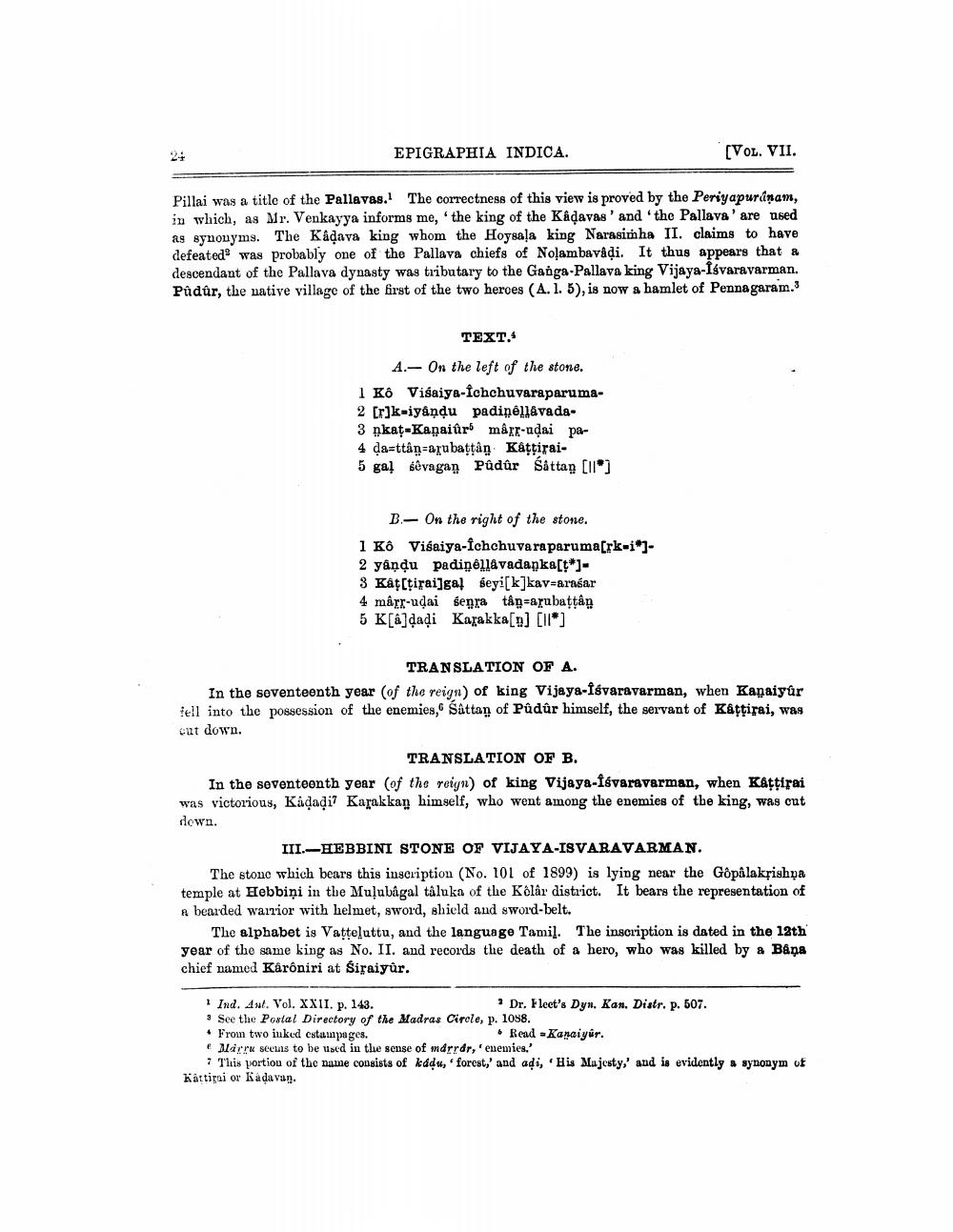________________
EPIGRAPHIA INDICA.
[VOL. VII.
Pillai was a title of the Pallavas. The correctness of this view is proved by the Periyapuraṇam, in which, as Mr. Venkayya informs me, 'the king of the Kâḍavas' and 'the Pallava' are used as synonyms. The Kâdava king whom the Hoysala king Narasimha II. claims to have defeated was probably one of the Pallava chiefs of Nolambavâḍi. It thus appears that a descendant of the Pallava dynasty was tributary to the Ganga-Pallava king Vijaya-Îévaravarman. Pûdûr, the native village of the first of the two heroes (A. 1. 5), is now a hamlet of Pennagaram.3
TEXT.1
A. On the left of the stone.
1 Kô Visaiya-fchchuvaraparuma
2 [r]k-iyâṇḍu padinellavada
3 nkat-Kapaiûr mârr-uḍai pa
4 da=ttân-arubaṭṭân Kâṭṭirai
5 gal sêvagan Pûdûr Śâttan [*]
B. On the right of the stone.
1 Kô Visaiya-Îchchuvara paruma[rk-i*]
2 yaṇḍu padiņêllavadanka[*]
3 Kat[ṭirai]gal seyi[k]kav-arasar
4 marr-udai senra tân=arubattân 5 Kaldadi Kaçakka[n] [*]
TRANSLATION OF A.
In the seventeenth year (of the reign) of king Vijaya-Îsvaravarman, when Kanaiyûr fell into the possession of the enemies, Sâttan of Pûdûr himself, the servant of Kâṭṭirai, was cut down.
TRANSLATION OF B.
In the seventeenth year (of the reign) of king Vijaya-févaravarman, when Kâṭṭirai was victorious, Kádadi Karakkan himself, who went among the enemies of the king, was cut
down.
III.
HEBBINI STONE OF VIJAYA-ISVARAVARMAN.
The stone which bears this inscription (No. 101 of 1899) is lying near the Gopalakrishna temple at Hebbiņi in the Mulubâgal tâluka of the Kôlâr district. It bears the representation of a bearded warrior with helmet, sword, shield and sword-belt.
The alphabet is Vatteluttu, and the language Tamil. The inscription is dated in the 12th year of the same king as No. II. and records the death of a hero, who was killed by a Bâņa chief named Kârôniri at Siraiyûr.
1 Ind. Aut. Vol. XXII. p. 143.
* See the Postal Directory of the Madras Circle, p. 1058. From two inked estampages.
e Marru seems to be used in the sense of marrdr,' enemies.'
7 This portion of the name consists of kádu, forest,' and adi, His Majesty,' and is evidently a synonym of Kattirai or Kadavan.
Dr. Fleet's Dyn. Kan. Distr. p. 507.
Read Kanaiyur.




